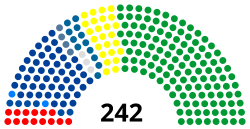House of Councilors
|
House of Councillors 参議院 Sangiin |
|
|---|---|
 |
|
| Type | |
| Type | |
| Leadership | |
|
Opposition leader
|
|
| Structure | |
| Seats | 242 |
 |
|
|
Political groups
|
Party strength before 191st DietGovernment (146)
LDP (121)
Kōmeitō (25)
Revisionist opposition (15)
Initiatives (12)
PJK (3)
Other opposition (69)
DP (49)
JCP (14)
Energize (2)
SDP (2)
LP (2)
Independents & others (12)
Government-aligned independents (3)
Opposition-aligned independents (5)
OSMP (1)
Other independents (3)
|
| Elections | |
|
Parallel voting: Single non-transferable vote (146 seats) Party-list proportional representation (96 seats) Staggered elections |
|
|
Last election
|
July 10, 2016 |
| Meeting place | |
 |
|
| National Diet Building, Tokyo | |
| Website | |
| www.sangiin.go.jp | |
Coordinates: 35°40′35.5″N 139°44′40.5″E / 35.676528°N 139.744583°E
Party strength before 191st DietGovernment (146)
Revisionist opposition (15)
Other opposition (69)
Independents & others (12)
The House of Councillors (参議院 Sangiin?) is the upper house of the National Diet of Japan. The House of Representatives is the lower house. The House of Councillors is the successor to the pre-war House of Peers. If the two houses disagree on matters of the budget, treaties, or designation of the prime minister, the House of Representatives can insist on its decision. In other decisions, the House of Representatives can override a vote of the House of Councillors only by a two-thirds majority of members present.
The House of Councillors has 242 members who each serve six-year terms, two years longer than those of the House of Representatives. Councillors must be at least 30 years old, compared with 25 years old in the House of Representatives. The House cannot be dissolved, as only half of its membership is elected at each election. Of the 121 members subject to election each time, 73 are elected from the 47 prefectural districts (by single non-transferable vote) and 48 are elected from a nationwide list by proportional representation with open lists.
...
Wikipedia
